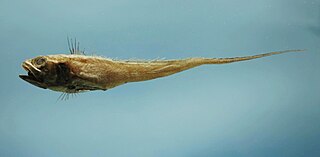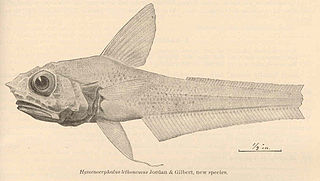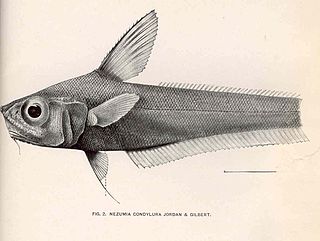
Grenadiers or rattails are generally large, brown to black gadiform marine fish of the subfamily Macrourinae, the largest subfamily of the family Macrouridae. Found at great depths from the Arctic to Antarctic, members of this subfamily are amongst the most abundant of the deep-sea fish.

Macrouridae is a family of deep sea fish, a diverse and ecologically important group, which are part of the order of cod-like fish, the Gadiformes. The species in the Macrouridae are characterised by their large heads which normally have a single barbel on the chin, projecting snouts, and slender bodies that taper to whip-like tails, without an obvious caudal fin but what there is of the caudal fin is often confluent with the posterior dorsal and anal fins. There are normally two dorsal fins, the anterior dorsal fin is quite high, the posterior quite low but is longer and takes up a greater proportion of the fish's of the back, species in the subfamily Macrouroidinae have a single dorsal fin. The long anal fin is almost as long as the second dorsal fin is nearly as long as the posterior dorsal, and sometimes it is longer. The pelvic fin is inserted in the vicinity of the thorax and normally has 5-17 fin rays but are absent in Macrouroides. The body is covered in small scales and if they have a photophore, it is usually on the midline of the abdomen just in front of the anus. The bioluminescence of these fish is produced by symbiotic bioluminescent bacteria. The structure of the skull has been used to show their placing in the Gadiformes, but they differ from the typical cods in that they possess one stout spine in the anterior dorsal fin.

Rajiformes is one of the four orders in the superorder Batoidea, flattened cartilaginous fishes related to sharks. Rajiforms are distinguished by the presence of greatly enlarged pectoral fins, which reach as far forward as the sides of the head, with a generally flattened body. The undulatory pectoral fin motion diagnostic to this taxon is known as rajiform locomotion. The eyes and spiracles are located on the upper surface of the head and the gill slits are on the underside of the body. Most species give birth to live young, although some lay eggs enclosed in a horny capsule.

The blacktip sawtail catshark is a species of catshark, and part of the family Scyliorhinidae, found off the coasts of Taiwan and the Philippines. It is demersal in nature and occurs deeper than 60 m (200 ft). Growing up to 46 cm (18 in) long, this slim-bodied species is characterized by its plain brownish dorsal coloration with dark tips on the dorsal and caudal fins, and a prominent crest of enlarged dermal denticles on the upper edge of the caudal fin. It is oviparous, with females producing encapsulated eggs two at a time year-round. The blacktip sawtail catshark is caught incidentally in bottom trawls and used for fishmeal in Taiwan.

Macrourus is a small benthopelagic genus of rattails from the family Macrouridae.

Bathygadus antrodes is a gadiform fish, a species of rattail. It is found at depths of up to 1200 m in the waters around southern Japan and northern Taiwan.

Gadomus colletti is a species of rattail. This deep-water fish is found in the waters around Japan, the Philippines, and northern Taiwan.
Coelorinchus asteroides is a species of rattail. This is a deep-water fish found in the waters around Taiwan and southern Japan.
The unicorn grenadier, Coelorinchus productus, is a species of rattail. This fish is found at depths of up to 600 metres (2,000 ft) in the waters around northern Taiwan, southern Japan and the East China Sea.

Hymenocephalus lethonemus is a species of rattail. It occurs at depths of up to 485 m (1591 ft) in the waters off southern Japan, the Philippines and northern Taiwan.

Hymenogadus gracilis, also known as the Graceful grenadier is a species of rattail fish. It is found at depths of 160–345 m (525–1,132 ft) in tropical and subtropical seas worldwide. This is one of the smallest of the rattails, growing to no more than 13 cm (5.1 in) in length. It is a slender fish with a large mouth, with rows of very small teeth, positioned in the underside of the skull. There is a short, thin chin barbel. It is more strikingly marked than most rattails, with bold black streaks on the head and black and silver barring over most of the body. There is a long bioluminescent organ with two lenses underneath the rear end of the body.
Kumba japonica is a species of rattail. It is found at depths of up to 710 m in the waters around Taiwan and southern Japan.
Lucigadus lucifer is a species of rattail. It is found at depths of up to 320 m in the waters around the Philippines and northern Taiwan.

The Japanese pugnose grenadier is a species of rattail fish. It is found at depths of up to 720 m (2362 ft) in the waters around southern Japan, northern Taiwan and in the East China Sea.
Pseudocetonurus septifer is a species of rattail, the only known species in the genus Pseudocetonurus. This fish is found at depths of up to 950 m in the waters around Hawaii and in the south-eastern Pacific. It has recently also been recorded on the other side of the Pacific, near Taiwan, and this species probably has a pan-Pacific distribution but has been underrecorded due to the depths in which it lives.
The arrowtooth grenadier is a species of rattail. This is a deep-water fish found at depths of up to 950 m. It was originally recorded from the waters around Hawaii but has recently also been recorded near Taiwan, which suggests it has a far wider distribution than previously thought.
The plainfin grenadier is a species of rattail. This is a deep-water fish found at depths of up to 772 m. It has a wide distribution in the Indian and western Pacific Oceans.
The Palau grenadier is a species of rattail. This is a deep-water fish found at depths of up to 710 m. It has been recorded from many parts of the Pacific Ocean including Hawaii, southern Japan, the Kyushu–Palau Ridge and northeastern Taiwan.
Ventrifossa rhipidodorsalis is a species of rattail. This is a deep-water fish found at depths of up to 535 m. It is found in waters off southern Japan, northeastern Taiwan, the Philippines, and in the South China Sea.
Ventrifossa saikaiensis is a species of rattail. This is a deep-water fish found at depths of up to 740 m. It is found in the waters off southern Japan and northeastern Taiwan.









